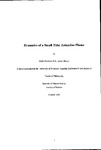Dynamics of a Small Tidal Estuarine Plume
| dc.contributor.author | Pritchard, Mark | |
| dc.contributor.other | School of Biological and Marine Sciences | en_US |
| dc.date.accessioned | 2013-09-18T09:03:46Z | |
| dc.date.available | 2013-09-18T09:03:46Z | |
| dc.date.issued | 2000 | |
| dc.identifier | NOT AVAILABLE | en_US |
| dc.identifier.uri | http://hdl.handle.net/10026.1/1819 | |
| dc.description | Merged with duplicate record 10026.1/844 on 13.03.2017 by CS (TIS) | |
| dc.description.abstract |
Small-scale estuarine plume discharges into adjacent seas are common inshore features responsible for the transportation and dispersion of brackish water in the coastal zone. However, the physics that govern small-scale mixing in the frontal regions of river plumes are still poorly understood. The current study quantified and compared the observed hydrodynamic properties present inside a radially spreading river plume discharge from the River Teign, Teignmouth, Devon, UK, to those predicted by a generic plume model. Numerical simulations designed to replicate time dependent radial plume spreading from a constant source predicted the development of an internal interfacial bore that lagged the surface plume front through radial distance and time from initial plume release. The model was scaled from time lapse X-band radar imagery that recorded several plume discharge events. Scaled model output predicted the internal bore to form approximately 180 m behind the leading surface front. Subsequent field studies employed instrumentation capable of recording high-resolution measurements of temperature, salinity and velocity, spatially and vertically throughout the plume's buoyant layer over two ebb tidal cycles. Results suggested the plume advanced at a rate dependent on a super-critical interfacial Froude number of 0(1.3) and was a region of intense mixing and downward mass entrainment. Temperature contours recorded through the stratified plume gave no indication of an internal bore in its predicted position but did show an abrupt shallowing of the interfacial region some 40 to 60 m behind the surface plimie front. Super-critical interfacial Froude and critical Gradient Richardson numbers present in this region of the plume implied that this was the position of the predicted bore. The form of the bore often appeared as an ensemble of undular internal hydraulic jumps rather than a singular discontinuity as predicted by the model. Bulk mixing analysis inside the leading front based on established gravity current theory suggested that the extent of turbulent exchange in the model frontal boundary condition P, was underestimated by about a factor of 2. With the required increase in p, model simulations showed a decrease in the lag distance of internal bore formation to one where critical Froude numbers were detected inside the actual plume. Throughout both surveys, the gravity head remained a reasonably constant size due to any increase in across frontal velocity over the ebb tidal cycle being matched by an increase in entrainment and mixing. The subsequent conclusions from the study show the outflow and mixing dynamics are controlled by the estuary's tidal modulation of estuarine brackish water outflow / plume inflow rate behind the leading plume frontal discontinuity. | en_US |
| dc.language.iso | en | en_US |
| dc.publisher | University of Plymouth | en_US |
| dc.title | Dynamics of a Small Tidal Estuarine Plume | en_US |
| dc.type | Thesis | |
| plymouth.version | Full version | en_US |
| dc.identifier.doi | http://dx.doi.org/10.24382/4648 | |
| dc.identifier.doi | http://dx.doi.org/10.24382/4648 |
Files in this item
This item appears in the following Collection(s)
-
01 Research Theses Main Collection
Research Theses Main


